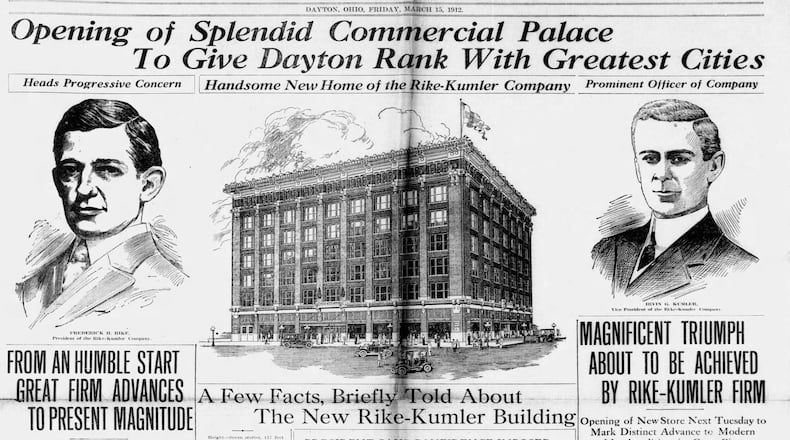The Rike-Kumler company was established in downtown Dayton in 1853. David L. Rike and his associates started modestly near Third Street on Main.
The business began when the firm of Prugh, Joyce & Rike was organized. This organization continued for a short time until Joyce retired. The firm of Prugh & Rike continued for a few years until Prugh wished to go into the wholesale business and Rike took the retail.
Rike Dry Goods company
In the early 1860s, Rike associated with Robert I. Cummin and Samuel E. Kumler and the firm of D.L. Rike & Co. began and continued with business until 1892, when the firm was incorporated as The Rike Dry Goods company. David L. Rike, Robert I. Cummin, Samuel E. Kumler with Frederick H. Rike, son of D.L. Rike, and Irvin G. Kumler, son of Samuel E. Kumler, as incorporators.
They wanted a new location, and the southwest corner of Fourth and Main streets. was selected. Early in 1893 a new building was begun, and in September 1893, the business moved from the former location, 15 and 17 East Third St. where it had been established 40 years before.
President David L. Rike died on Oct. 23, 1895 and Robert I. Cummin died shortly thereafter. The company then named Frederick H. Rike president.
The Rike-Kumler Building
In February 1908, the corporate name of the company was changed from The Rike Dry Goods company to The Rike-Kumler company.
Early in 1909 business was so good that the company again started looking for a new location, and the site at Second and Main was secured.
The store moved the Second and Main streets in downtown Dayton and held a laying of the cornerstone ceremony there Aug. 10, 1911. A tin box was placed inside the cornerstone which included the history of the Rike-Kumler enterprise and the names of the present organization, the builders of the new store and a copy of the Rike creed.
According the that day’s Dayton Journal Herald, President Frederick Rike read the company creed at the event, which was, “We believe in Dayton and its growth. We believe that a good name, absolute integrity, honest value, courtesy and kindness, progress, originality, dignity, justice and love of work are bound to win, and these are, and shall remain, the fundamental principles of our business.”
The cost of the new building, fixtures and equipment were approximated at that time to be $550,000.
When the new building opened on Tuesday, March 19, 1912, there were between 400 and 500 employees working there. At the time, it was reported that thousands within a radius of 75 miles attended the opening.
Credit: Dayton Daily News archives
Credit: Dayton Daily News archives
Rike’s Holiday Windows
The history of the window displays, according to Dayton historian Curt Dalton, can be traced back to 1943 when the National Cash Register Co. placed five scenes from Charles Dickens’ “A Christmas Carol” in its New York City office windows. Dressed in period attire, the figures were incorporated into elaborate backgrounds built by NCR carpenters.
In 1945 Frederik Rike, owner of the Rike-Kumler Co., successfully campaigned to move the display into the windows of his department store at Second and Main streets in downtown Dayton. From that time on, a visit to the windows became a popular tradition for many families in the Miami Valley.
The Rikes “Wonderland Windows” are now displayed each season at the Wintergarden in the Schuster Center.
Later Years
In 1959, Rike’s became part of the Federated Department Stores.
In 1982, Rike’s merged with its Cincinnati unit, Shillito’s, and formed Shillito–Rikes.
In 1986, Shillito–Rikes merged into the Columbus-based Lazarus chain. This ended all uses of the Rike name.
Rike’s main store in downtown Dayton was imploded in 1999 and then became what is currently the site of the Benjamin and Marian Schuster Performing Arts Center.
In 2005, Lazarus was consolidated with most other Federated chains under the Macy’s brand.
About the Author






